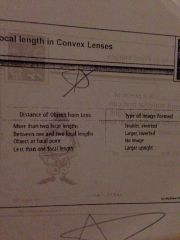![]()
![]()
![]()
Use LEFT and RIGHT arrow keys to navigate between flashcards;
Use UP and DOWN arrow keys to flip the card;
H to show hint;
A reads text to speech;
27 Cards in this Set
- Front
- Back
- 3rd side (hint)
|
Convex lenses in focal lengths |

Back (Definition) |
|
|
|
What is opaque |
Lets no light through |
|
|
|
Materials can ___, ____, or ____ light |
Transmit, absorb or reflect |
|
|
|
What is a shadow |
When an opaque object absorbs light rays |
|
|
|
Shadows demonstrate that light travels in _______ lines |
Straight |
|
|
|
Shadows demonstrate that light travels in _______ lines |
Straight |
|
|
|
What is a ray diagram |
Shows how distance from the light source affects size of the shadow an object makes |
|
|
|
What is reflection |
When light bounces off an object |
|
|
|
What is the incoming ray of light called |
Incident ray |
|
|
|
What is the normal |
An imaginary line perpendicular to the surface |
|
|
|
Angle of incidence us measured from the normal to the ____ ray |
Incident |
|
|
|
Angle of reflection is measured from normal to the _____ ray |
Reflected |
|
|
|
When light travels from one transparent medium to another, it ____ _____ |
Changes speed |
|
|
|
The bending of light due to a change in speed is called |
Refraction |
Refraction |
|
|
What is a convex mirror |
Mirror that curves inward |
|
|
|
What is a concave lens and an example |
Thinner in the middle than at the edge. They cause light rays to diverge and they produce images that are upright and smaller than the object
Example: eyeglasses |
|
|
|
What are convex lens |
Thicker in the middle than at the edge. cause light rays to converge
Example: magnifying glass |
|
|
|
What is a lens |
Piece of transparent material that can bend, or refract light rays to help firm a focused image |
|
|
|
What is a concave lens |
Thinner in the middle than at the edge. They cause light rays to diverge and they produce images that are upright and smaller than the object
Example: eyeglasses |
|
|
|
What are convex rays |
Thicker in the middle than at the edge. cause light rays to converge
Example: magnifying glass |
|
|
|
Distance from the centre of the lens to the focal point is called |
The focal lenght |
|
|
|
Convex lenses in focal lengths |

Back (Definition) |
|
|
|
What is a smooth flat mirror called |
Plane mirror |
|
|
|
what do plane mirrors form |
Image that is upright and appears to be as far behind the mirror as the object is in front of it |
|
|
|
What is a concave mirror |
A mirror that curves inward |
|
|
|
Two characteristics formed by a convex mirror |
Objects appear smaller than they are and more objects can be seen in a convex mirror than a plane mirror |
|
|
|
What is a convex mirror |
Mirror that curves outward |
|

